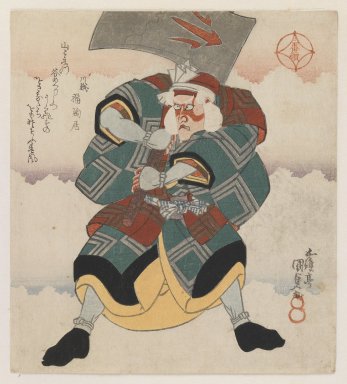
Artist:Utagawa Kunisada (Toyokuni III)
Medium: Woodblock print, shikishiban format; deluxe printing
Geograhical Locations:
Dates:circa 1828
Dimensions: 6 5/16 x 7 7/8 in. (16 x 20 cm)
Collections:
Accession Number: 2002.121.6
Image: 2002.121.6_IMLS_PS3.jpg,
Catalogue Description: Male actor in fierce role, wielding a large axe Signed: Gototei Kunisada ga Condition: Excellent Arrived matted in all-rag 16 x 20 in. mat The square emblems on the sleeve identify the actor as one of the Ichikawa Danjuro line. The date and profile suggest that it is VII. Although the green-and-rust costume and large axe would usually identify the actor as famous villain Sekibei, in this case the white wig, inscription, and two accompanying prints in the triptych all indicate that the actor is playing an elderly woodsman in a dance/drama about the youth of Kintaro, who grew up in the wilderness, raised by a "mountain hag" (Yama-uba) who may or may not have been his mother. The print is a privately-sponsored surimono, printed with the delicate lines and printing flourishes typical of deluxe, small editions. It was originally the center sheet of a triptych, with another male figure with large axe at the left (the super-strong boy Kintaro, also known as Kaidomaru, played by Iwai Kumesaburo II) and a female figure at the right (the mountain hag, played by Segawa Kikunojo V). Made for the Shipporen Kyoka (poetry) club, which was active from 1825 to 1835. The club's seal appears at the upper right. With no known performance of this subject involving these three actors, the staging is likely imaginary. The triptych likely dates to around 1828 as per the way Kunisada signed, and the selection and appearance of the three actors. Would have been released to celebrate the new year. The poem on this sheet is signed by Fukutokyo, of Kawagoe. All members of the poetry club adopted the prefix "Fuku" (the character means good luck) in honor of the club's founder, Fukunoya Uchinari. In this group, they describe themselves as being from Kawagoe, a castle town in Saitama Prefecture, northwest of Tokyo. [Interpretation and translations provided by John Carpenter, April 2020.]